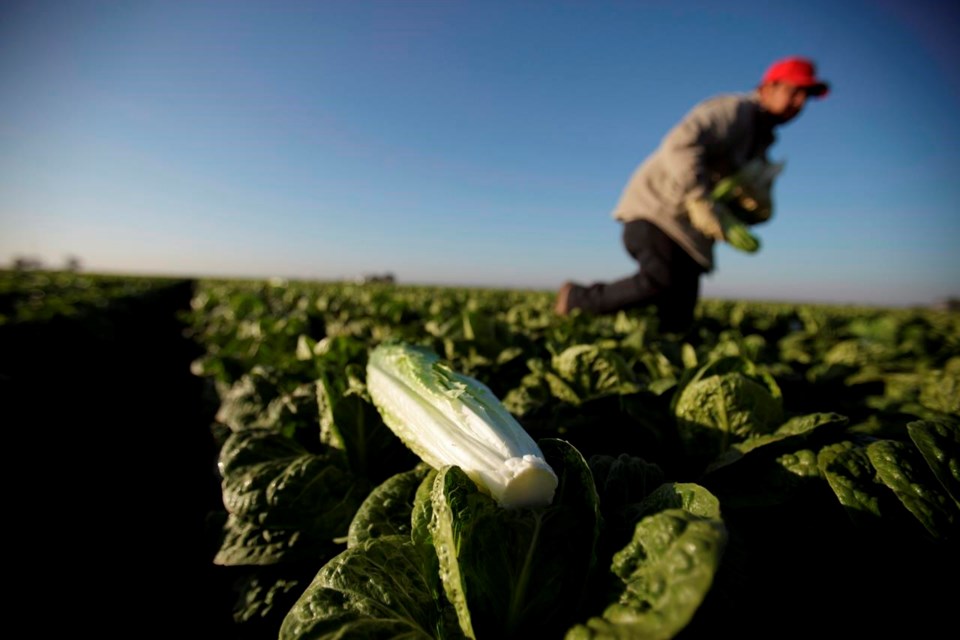Lettuce prices are likely to rise next month and could stay high into the summer, agriculture experts say, as flooding in a key California farming area becomes the latest example of extreme weather’s effect on the food chain.
The Salinas Valley, where a vast amount of lettuce and other produce eaten in North America is grown every year, has seen severe rain and storms since the beginning of the year, said John Bishop, national buyer for produce distributor Fresh Start Foods.
All that extra water has flooded fields and delayed planting, Bishop said, causing hundreds of thousands of dollars in crop damage.
“It’s been very concerning,” he said.
Tens of thousands of acres of farmland have flooded in Salinas since the beginning of the year, Mark Shaw, vice-president of operations for California-based Markon Cooperative said in an email. Below-average temperatures are adding to farmers’ struggles, he added.
Salinas is the same region where disease struck lettuce crops last fall, creating severe shortages and persistently high prices in iceberg and Romaine lettuce that caught the attention of Canadian consumers at grocery stores. It was a situation Bishop said he’s never experienced in his many years in the produce business.
Every November, production of lettuce and some other vegetables shifts to warmer desert areas, notably in Yuma, Ariz. as well as California’s Imperial Valley. But the second week of April is when most production moves back to Salinas, said Bishop — and this spring, the region won’t be ready.
“Basically, we are setting up for another demand-exceeds-supply market driving up prices as we experienced last October, November and December,” said Shaw, who anticipates four to six weeks of limited supply.
But Bishop anticipates a “significant gap” could even last until July.
The agriculture industry is used to getting creative in order to deal with wild weather, said Ron Lemaire, president of the Canadian Produce Marketing Association. Right now, farmers in California are deploying every tool they have to mitigate the effects of the rain, he said, but there will still be less production in the coming months, which usually sends prices higher.
Weather is the biggest factor affecting produce prices, followed by transportation costs, said Rich Donsky, co-owner of Ontario-based distributor Mister Produce.
So it’s no surprise that the farming industry is investing more in controlled-environment agriculture, such as greenhouses and vertical farms, said Bishop.
For example, Fresh Start’s parent company Gordon Food Service has partnered with indoor farming company Square Roots, building indoor farms in locations across the U.S. including at GFS distribution centres.
“We believe that it is the future of agriculture, and it's the future of our food supply,” said Bishop.
The industry has recently seen more interest in year-round production in Canada, too, as climate change makes issues like extreme weather and drought more prevalent, said Sylvain Charlebois, a Dalhousie University professor and director of the school's Agri-Food Analytics Lab.
Bishop anticipates the push to grow more produce in Canada will continue.
"Where we get our food from, and how it gets to us, all contributes to the cost of what we're buying. So it only makes sense to find ways to be able to produce products on a local basis," he said.
The greenhouse industry won’t ever replace outdoor growing, said Lemaire, but he believes it can fill in gaps in the supply chain.
“It is part of the solution, but it's not the full solution,” he said.
Major food companies are making investments in Canadian-grown produce, said Charlebois, such as McCain Foods, which has invested millions in vertical farming company GoodLeaf Farms.
California-based berry giant Driscoll’s has recently partnered with Canadian farmers to grow some berries north of the border, he said.
And in 2020, Wendy’s announced it would use Alberta greenhouse-grown lettuce in all its salads and sandwiches.
Vertical farming has been getting a lot of attention (and capital) recently, but Lemaire said he thinks the business model needs further development. Donsky, too, thinks there’s potential in vertical farming but more technological advancement is needed.
Charlebois expects investment in local produce to continue in the coming years.
“I think there is an awakening ... of how vulnerable we are, especially when it comes to fruits and vegetables. And not just during the winter months, but all year round.”
This report by The Canadian Press was first published March 27, 2023.
Rosa Saba, The Canadian Press
